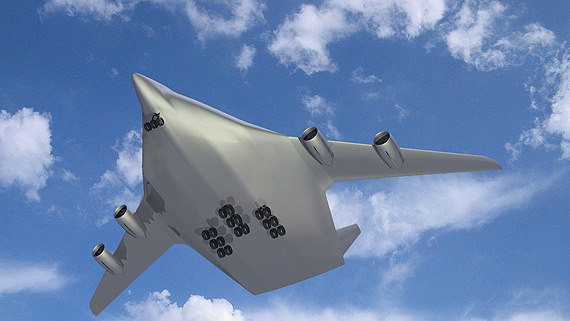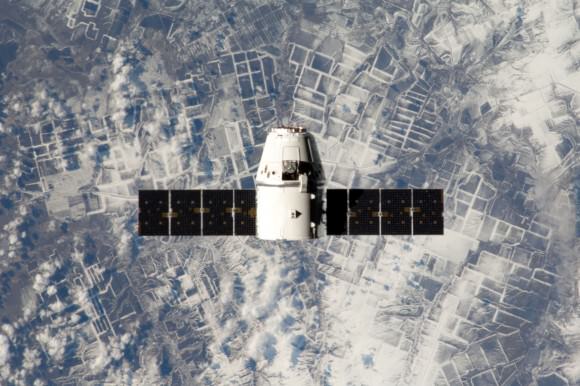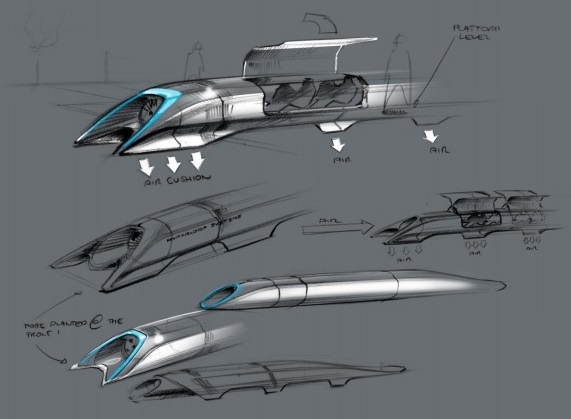This week, SpaceX founder and billionaire Elon Musk (who also founded electric vehicle manufacturer Tesla Motors) released his vision for a futuristic transportation system. Called hyperloop, it’s supposed to be better than flying supersonic over short distances. To give you a quick overview, we’ve summarized a portion of his paper below.
What is a hyperloop? In Musk’s words, a hyperloop is a system to “build a tube over or under the ground that contains a special environment.” Cars would basically be propelled in this tube. One example could be a huge sort of pneumatic tube where high-speed fans would compress and push the air — although the friction implications make Musk skeptical that it would work. Another option is having a vacuum in the tube and using electromagnetic suspension instead. Musk acknowledges it is hard to maintain a vacuum (one small leak in hundreds of miles of tubing, and the system shuts down), but there are pumping solutions to overcome this. He favors the second solution.
What is the motivation? Musk is seeking an alternative to flying or driving that would be “actually better than flying or driving.” He expressed disappointment that a proposed high-speed rail project in California is actually one of the slowest and most expensive of its type in the world, and speculated that there must be a better way.
What is the biggest technical challenge? Overcoming something called the Kantrowitz limit. Musk describes this as the “top speed law for a given tube to pod area ratio”. More simply, if you have a vehicle moving into an air-filled tube, there needs to be a minimum distance between the walls of the vehicle and the walls of the tube. Otherwise, Musk writes, “the capsule will behave like a syringe and eventually be forced to push the entire column of air in the system. Not good.”

How will Musk overcome that challenge? The principal ways of getting around it is to move slowly or quickly. A hyperfast speed would be a “dodgy prospect”, Musk writes, so his solution is to put an electric compressor fan on the capsule nose that would move high-pressure air from the front to the back of the vehicle. As a bonus, this would reduce friction. Yes, there are batteries available that would have enough power to keep the fan running for the journey’s length, he says.
How is hyperloop powered? Solar panels would be placed on top of the tube, providing enough juice to keep the vehicles moving, according to Musk’s calculations.
What about earthquakes? Musk acknowledges that a long-range system is susceptible to earthquakes. “By building a system on pylons, where the tube is not rigidly fixed at any point, you can dramatically mitigate earthquake risk and avoid the need for expansion joints,” he writes.

Where would hyperloop be used? In a description of the system, Musk says the hyperloop would be best served in “high-traffic city pairs that are less than about 1,500 km or 900 miles apart.” Anything more distant, and supersonic travel would be the best solution. (Short distance supersonic travel isn’t efficient because the plane would spend most of its time ascending and descending.)
Is it cost-effective? Musk estimates the tube would be “several billion dollars”, which he describes as low compared to the “tens of billion [sic] proposed for the track of the California rail project.” The individual capsules would be several hundred million dollars. Moreover, building a tube instead of a railway offers advantages, Musk says: it can be built on pylons (meaning you don’t need to buy the land), it’s less noisy, and there’s no need for fencing.
I want more information. Musk wrote a technical proposal that spans several dozens of pages, which you can check out here. He calls his system an open-source one and seems to be open to ideas to improve it.
Feel free to leave your feedback in the comments. Does this look feasible? Is there anything that could be added to make it a better system?


A vacuum tube can be deadly when there is a leak in the cabin..
A plane crashing is also deadly…..
Where would you get the solar panels?
Well, it just so happens Musk sells them!
Thought he leased them.
Can’t blame someone for developing their interests.. especially if it aligns with the direction we all need to go… We simply MUST kick the oil habit however, wherever and whenever we can! So sayeth the birds, fish and bees and all the other critters from micro-organism on up to blue whale! I will speak for thee!
I thought he was talking about moving the whole column of air. Vacuum in the front, pressure in the back. Guess not.
The higher the pressure behind the vehicle the more propulsive force it would have. Tube evacuation would allow high altitude like speeds with turbo-electric compressors. The vacuum does not have to be incredibly high… a 747 flying at 40,000 ft. sees a vacuum pressure of about 80.0 torr w/temp -60.0 C. Semi conductor manufacture sees 10^-6 torr.
I was thinking a couple of large turbofans pushing air into the tube behind and a couple of large turbofans drawing air out on the other side. Who cares if it leaks a little? The turbofans are going to suck air like crazy.
Flip those around for the trip back.
You could have pressure release and inlet ports all along the way to modulate airflow (in addition to altering fan speed), such that the turbofans always have plenty of air to breathe–or low enough back pressure for them to blow, as the case may be.
One more thing: Because they can be high-bypass, plenty of breathable air will always be circulated.
You could even route the combustion exhaust directly out.
One more thing: Because they can be high-bypass, plenty of breathable air will be always be circulated.
For super high speeds this turbo electric jet propulsion vehicle could be further accelerated with solar powered ‘wind tunnel’ bypass fans mounted occasionally along the tube….
That is a very interesting idea. create a vacuum for a short duration just in front of the capsule with vacuum pumps fixed to the walls. The energy can be charges on capacitors and only be needed to suck air for a few seconds.
Why not use an system of propulsion based on the way CERN moves atoms. Would need to worry about air in the way of the tube by providing vents for it to escape as the pressure would build.
Electrical fire would be my biggest concern. Remember the BART fire under SF bay? Otherwise I’m game. Let’s build one!
Electrical fires would not be the biggest problem in his mostly evacuated tube. Consider that it is at the equivalent altitude of a proposed hypersonic airliner with the same cabin sealing problems to deal with. I doubt seriously that if it is ever built they will have fourteen access doors in each capsule as shown in his ‘white paper’.
The vacuum leak rate needs only to be contained for the duration of the 35 minutes of travel. It is not nearly as dire as on the ISS. More problematic as I see it is keeping the tube itself from leaking. In the 1930’s Michelson’s workforce(he had died before it was begun) tried to keep a moderate vacuum in a 48inch diameter, 1 mile long tube in which they attempted to measure the speed of light in a vacuum. From what I have read the effort was not as successful as his measurements up on Mt. Wilson,California between that mountain and another 22 miles away through air.
My first thought when I saw his concept was that JMS already thought of it long ago and made it part of the TV show Babylon 5. JMS simply put it on Mars.
Not mentioned is closing the ‘Road Kill Cafe’…. hmm… Sounds good for the Mars Express… aka keep the dust out?
Too bad he said he cant make the project go, that testa and spacex are his priorities, while true he could have avoided those words for the image of the project, hope some big pocket man takes it, maybe a couple of cities….
Could such a tube be used to accelerate a conventional rocket to a good start? Using electricity in a reusable ground fascility in order to reduce the rocket fuel needed.